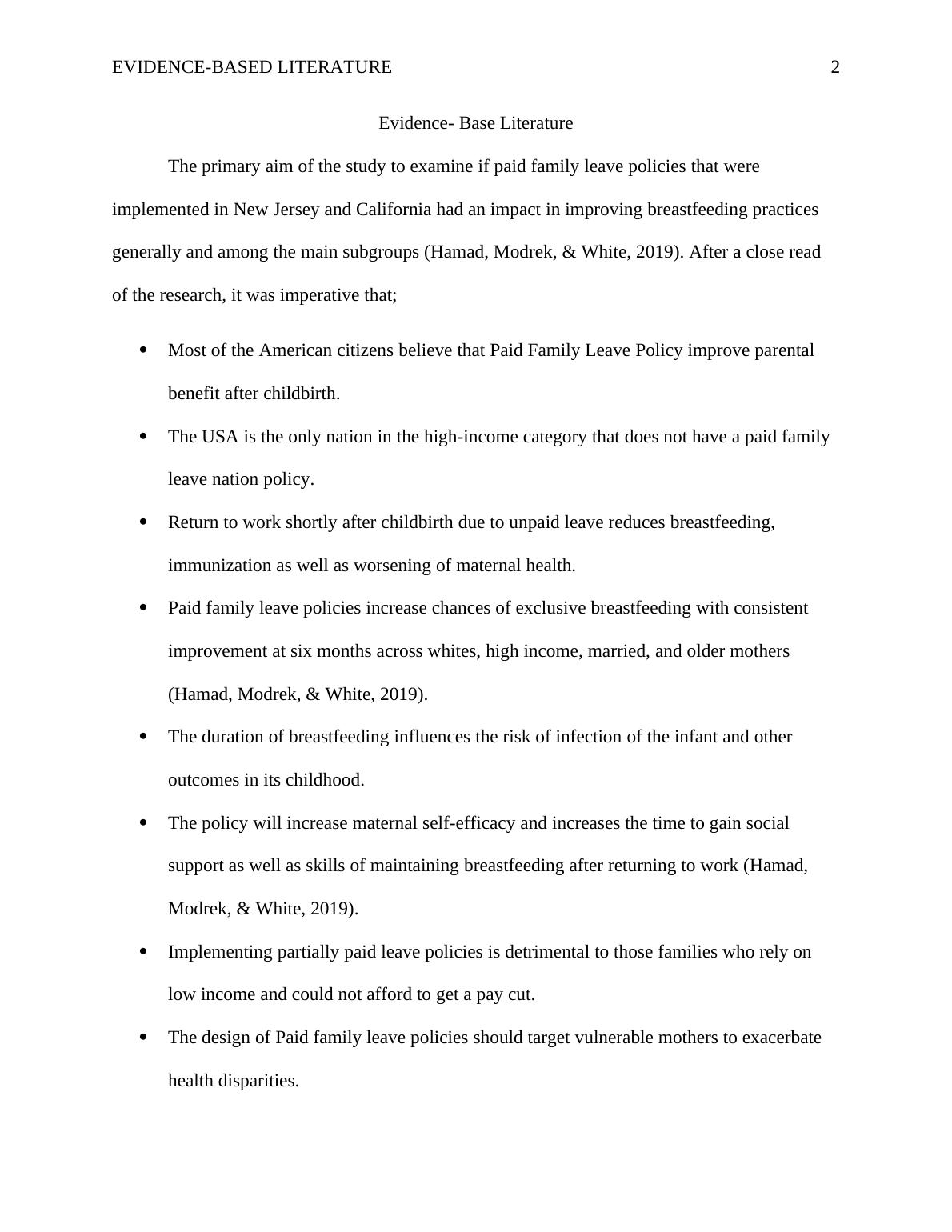Literature Review | Evidence- Base Literature
Added on 2022-10-09
4 Pages364 Words21 Views
Running head: EVIDENCE-BASED LITERATURE 1
Evidence- Base Literature
Student’s Name
Institutional Affiliation
Evidence- Base Literature
Student’s Name
Institutional Affiliation

EVIDENCE-BASED LITERATURE 2
Evidence- Base Literature
The primary aim of the study to examine if paid family leave policies that were
implemented in New Jersey and California had an impact in improving breastfeeding practices
generally and among the main subgroups (Hamad, Modrek, & White, 2019). After a close read
of the research, it was imperative that;
Most of the American citizens believe that Paid Family Leave Policy improve parental
benefit after childbirth.
The USA is the only nation in the high-income category that does not have a paid family
leave nation policy.
Return to work shortly after childbirth due to unpaid leave reduces breastfeeding,
immunization as well as worsening of maternal health.
Paid family leave policies increase chances of exclusive breastfeeding with consistent
improvement at six months across whites, high income, married, and older mothers
(Hamad, Modrek, & White, 2019).
The duration of breastfeeding influences the risk of infection of the infant and other
outcomes in its childhood.
The policy will increase maternal self-efficacy and increases the time to gain social
support as well as skills of maintaining breastfeeding after returning to work (Hamad,
Modrek, & White, 2019).
Implementing partially paid leave policies is detrimental to those families who rely on
low income and could not afford to get a pay cut.
The design of Paid family leave policies should target vulnerable mothers to exacerbate
health disparities.
Evidence- Base Literature
The primary aim of the study to examine if paid family leave policies that were
implemented in New Jersey and California had an impact in improving breastfeeding practices
generally and among the main subgroups (Hamad, Modrek, & White, 2019). After a close read
of the research, it was imperative that;
Most of the American citizens believe that Paid Family Leave Policy improve parental
benefit after childbirth.
The USA is the only nation in the high-income category that does not have a paid family
leave nation policy.
Return to work shortly after childbirth due to unpaid leave reduces breastfeeding,
immunization as well as worsening of maternal health.
Paid family leave policies increase chances of exclusive breastfeeding with consistent
improvement at six months across whites, high income, married, and older mothers
(Hamad, Modrek, & White, 2019).
The duration of breastfeeding influences the risk of infection of the infant and other
outcomes in its childhood.
The policy will increase maternal self-efficacy and increases the time to gain social
support as well as skills of maintaining breastfeeding after returning to work (Hamad,
Modrek, & White, 2019).
Implementing partially paid leave policies is detrimental to those families who rely on
low income and could not afford to get a pay cut.
The design of Paid family leave policies should target vulnerable mothers to exacerbate
health disparities.

End of preview
Want to access all the pages? Upload your documents or become a member.
Related Documents
Assignment Name.lg...
|3
|456
|114
Evidence Based Commentary: Breastfeedinglg...
|10
|1840
|371
